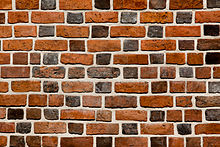
Back Baksteen Afrikaans ጡብ Amharic Ladriello AN طابوق Arabic Lladriyu AST Asinikan ATJ Kərpic Azerbaijani کرپیج AZB Кирбес Bashkir Plints BAT-SMG
| Brick | |
|---|---|
 A single brick. |


A brick is a type of construction material used to build walls, pavements and other elements in masonry construction. Properly, the term brick denotes a unit primarily composed of clay, but is now also used informally to denote units made of other materials or other chemically cured construction blocks. Bricks can be joined using mortar, adhesives or by interlocking.[1][2] Bricks are usually produced at brickworks in numerous classes, types, materials, and sizes which vary with region, and are produced in bulk quantities.[3]
Block is a similar term referring to a rectangular building unit composed of clay or concrete, but is usually larger than a brick. Lightweight bricks (also called lightweight blocks) are made from expanded clay aggregate.
Fired bricks are one of the longest-lasting and strongest building materials, sometimes referred to as artificial stone, and have been used since c. 4000 BC. Air-dried bricks, also known as mudbricks, have a history older than fired bricks, and have an additional ingredient of a mechanical binder such as straw.
Bricks are laid in courses and numerous patterns known as bonds, collectively known as brickwork, and may be laid in various kinds of mortar to hold the bricks together to make a durable structure.
- ^ "Interlocking bricks & Compressed stablized earth bricks - CSEB". Buildup Nepal.
- ^ "Bricks that interlock".
- ^ W., Beamish, A. Donovan (1990). Village-level brickmaking. Vieweg. ISBN 3-528-02051-2. OCLC 472930436.
{{cite book}}: CS1 maint: multiple names: authors list (link)